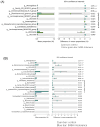Characteristics of Mucosa-Associated Microbiota in Ulcerative Colitis Patients with 5-Aminosalicylic Acid Intolerance
- PMID: 39335641
- PMCID: PMC11428711
- DOI: 10.3390/biomedicines12092125
Characteristics of Mucosa-Associated Microbiota in Ulcerative Colitis Patients with 5-Aminosalicylic Acid Intolerance
Abstract
Background/objectives: 5-Aminosalicylic acid (5-ASA) is a first-line therapy for ulcerative colitis (UC). This study examined the mucosa-associated microbiota (MAM) in UC patients, distinguishing between those who were 5-ASA tolerant and intolerant.
Methods: Brushing samples were collected from the sigmoid and ileal end of patients with UC during endoscopic procedures. The samples were profiled by using the Illumina MiSeq platform. The V3-V4 regions of the 16S rRNA gene (460 bp) were amplified by using tailed PCR.
Results: A total of 15 patients with 5-ASA intolerance, 38 patients with 5-ASA tolerance, and 19 healthy controls were recruited in this study. The α-diversity indices were remarkably different among the three groups in the ileum mucosa but not in the sigmoid colon. In the ileum mucosa, Alistipes, Ruminococcaceae, and Odoribacter were less abundant in the 5-ASA-intolerant group than in the control and 5-ASA-tolerant groups. On the contrary, Merdibacter, Brevundimonas, and Porphyromonas were more abundant in the 5-ASA-intolerant group than in other groups.
Conclusions: The present study showed that the changes in MAM were characterized by a decrease in mucoprotective bacteria rather than an increase in harmful bacteria.
Keywords: 5-ASA intolerance; dysbiosis; gut microbiota; mucosa-associated microbiota; ulcerative colitis.
Conflict of interest statement
The authors declare no conflicts of interest.
Figures












References
-
- Chu H., Khosravi A., Kusumawardhani I.P., Kwon A.H.K., Vasconcelos A.C., Cunha L.D., Mayer A.E., Shen Y., Wu W.-L., Kambal A., et al. Gene-Microbiota Interactions Contribute to the Pathogenesis of Inflammatory Bowel Disease. Science. 2016;352:1116–1120. doi: 10.1126/science.aad9948. - DOI - PMC - PubMed
LinkOut - more resources
Full Text Sources

